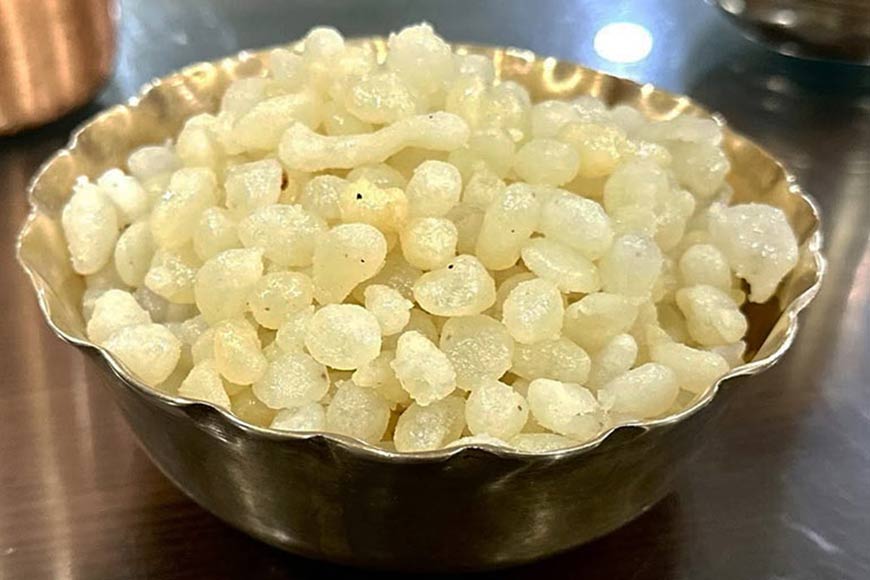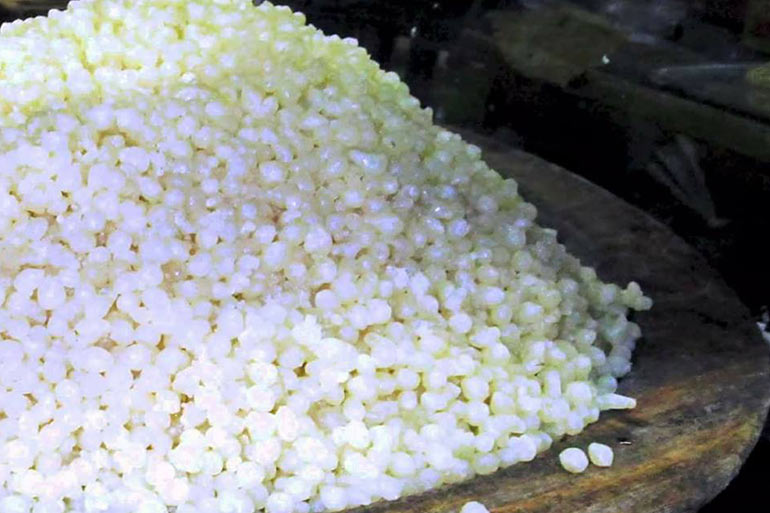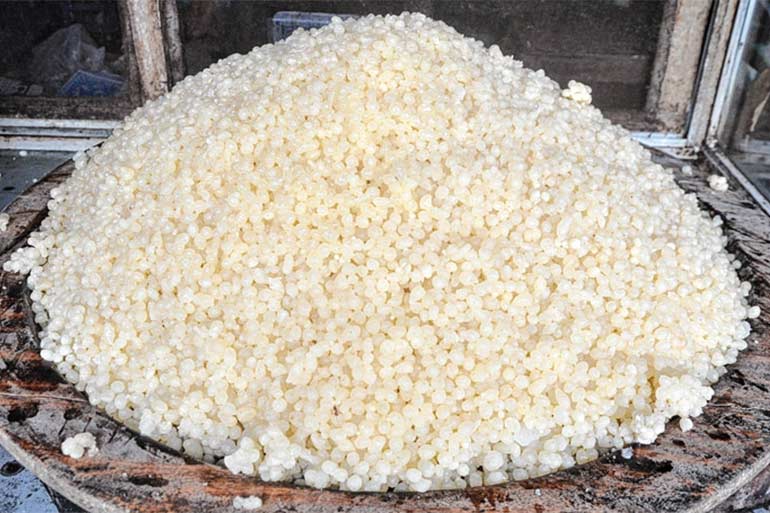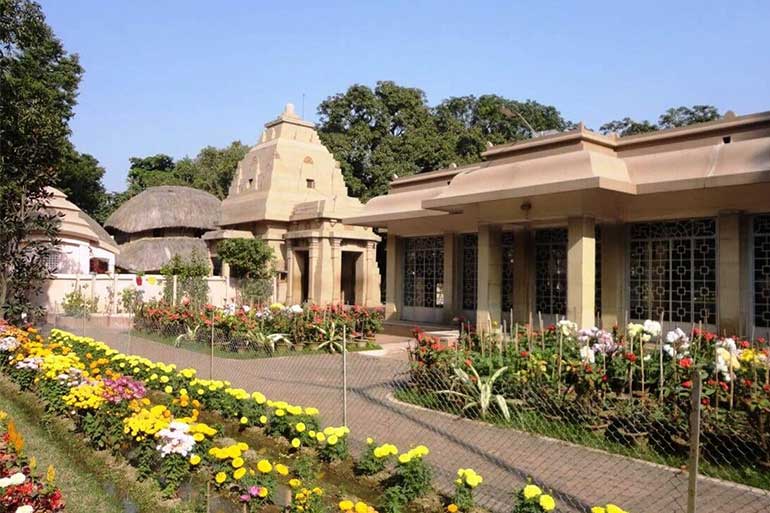A taste of faith: how Kamarpukur’s white boondi reflects devotion to Sri Ramakrishna- GetBengal story

The sweet-makers of Bengal’s villages are no less than Nobel-winning scientists when it comes to their craft. Take boondi, for example, a sweet whose name comes from the Sanskrit word Binduka, meaning tiny drops. Normally, we consider it a bright mix of red and yellow. But Bengali sweet-makers turned it colourless, and still made it full of flavour!
This simple white boondi has now earned a GI (Geographical Indication) tag. It comes from Kamarpukur in Hooghly, a place made famous as the birthplace of Sri Ramakrishna Paramhansa. Local legends say that Ramakrishna himself was fond of this sweet.
Today, almost every sweet shop in Kamarpukur makes this white boondi, and it sells for Rs. 140 per kg.
After speaking to several boondi makers in Kamarpukur, we found that the key ingredients of the white boondi are Atop chaal and Rama kolai or Rambha kolai, which is actually the seed of the broad bean (borboti).

The artisans shared their special ratio also. Atop chal and Rama kolai are mixed in a 2:1 proportion to make the boondi batter. The method is quite simple; the batter is poured through a sieve and deep-fried, then dipped in sugar syrup.
Since the boondi is taken out as dry after soaking in syrup, it lasts longer. That’s the beauty of sugar-coated sweets; they stay fresh for several days without spoiling.
According to local legends, Sri Ramakrishna was fond of white boondi. Even today, it is offered in front of his idol at the temple and distributed as prasad in Kamarpukur. However, there is no written record confirming that white boondi was his favourite sweet. On the other hand, there are several written accounts that talk about his love for jalebi.
You can still find white boondi in the sweet shops around Sri Ramakrishna’s birthplace which is now the Ramakrishna Math. In 1947, the Ramakrishna Math and Mission took over his ancestral home and turned it into a pilgrimage site. Since then, the journey of Kamarpukur’s white boondi truly began.
According to local stories, Sri Ramakrishna had a neighbour named Satyakinkar Modak. Whenever young Gadadhar (Sri Ramakrishna’s childhood name) visited their home, he would be served jalebi and white boondi.
Sri Ramakrishna used to eat it, which means white boondi is at least 200 to 250 years old. According to local lore, it was being made even before his birth.
The same stories mention Satyakinkar Modak, also known as Satya Moyra. His sweet shop was the very first in Kamarpukur, located near Sri Ramakrishna’s ancestral home. Today, his descendants run several sweet shops in the area. Many sweet shops in Kamarpukur are named after “Thakur” (Sri Ramakrishna) or “Maa” (Holy Mother Sarada Devi). This could be a smart business move, or it might simply be a gesture of gratitude towards the one whose legacy still sustains the village.
There’s another story often heard in Kamarpukur. It’s said that young Gadadhar (Sri Ramakrishna) first tasted white boondi at the home of his friend Durgadas Modak. Durgadas’s father, Madhusudan Modak, also ran a sweet shop.
From what locals say, white boondi likely originated 200 to 225 years ago. The area was known for growing broad beans (borboti) in good quantity, and local food habits often followed the pattern of local farming. It is believed that the sweet-makers of Kamarpukur created white boondi as a smart way to use this locally grown crop.

Bongodorshon.com spoke to Shibashis Rakshit, son of Shasthi Rakshit, one of the key persons behind Shyamamoyee Mishtanna Bhandar, a famous sweet shop in Kamarpukur that’s been around for over 50 years.
He shared that they sell around two quintals of boondi every day on average. But during winter, especially when tourists visit, the demand for their white boondi increases a lot. Sometimes, the daily sales go beyond ten quintals during the peak season.
Shubhajit Laha and Bireshwar Modak, both sweet shop owners from Kamarpukur, have worked tirelessly to get the GI (Geographical Indication) tag for Kamarpukur’s famous white boondi.
Shubhajit, who runs the 50-year-old Srima Mishtanna Bhandar, told Bongodorshon, “Bireshwar and I took the initiative from the very beginning. We worked hard to get the GI tag. Now that it's finally approved, everyone is happy and celebrating, but the truth is, we didn’t get any support. When we first started talking about it, no one paid attention. During the process, sending samples, getting the tests done, we had to manage everything on our own. That’s the one thing that hurts.”
He further added, “There were many other items along with ours, like Baruipur’s guava, Jolbhora of Suryamodak, Mecha from Bankura, Motichur from Bishnupur, and Chanabora from Murshidabad. Not all of them received the GI tag. There were around 18 to 20 items in total, but we made it.
The Food Department of the West Bengal Government wanted to give us a counter at the Mishti Hub, but I had to decline for now since I already run two shops and managing everything would be too difficult.
Kamarpukur is a tourist destination. In winter, a lot of visitors come, and the demand for white boondi increases sharply. At other times, we mostly rely on local customers from nearby areas who buy throughout the year. After receiving the GI tag, even the people of our area are really happy.”
Shubhajit hopes that in the coming winter, tourists will show great interest and excitement in buying white boondi now that it has earned GI recognition.

The economy of Kamarpukur has been sustained largely by the deep devotion of countless followers of Sri Ramakrishna Paramhansa and Maa Sarada.
What was once a remote village has now grown into a popular tourist destination. And it is only because of the reverence for Thakur and Maa that a simple local delicacy like Rama Kalai’er boondi has earned such love and respect all these years. Now, with the Geographical Indication (GI) tag, this humble sweet is all set to gain wider recognition on a global stage.











